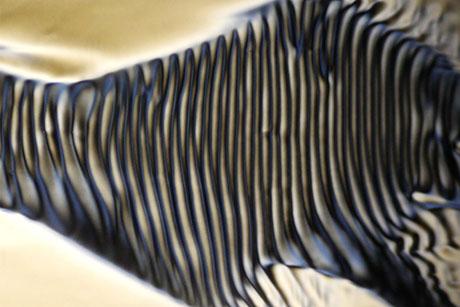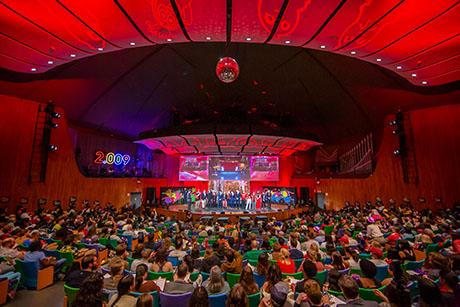Mens et Manus Across the Universe
MechE Faculty guide cross-cultural interest in replicating MIT teaching and research.
MechE faculty members are engineering for global change through their research, but that’s not the only way to make the world a better place.
Several are also collaborating with international universities and programs to help them emulate MechE’s hands-on approach in other parts of the world.
For example, Professor John Brisson is currently directing an education and research-focused collaboration with Singapore University of Technology and Design (SUTD); Professor Ahmed Ghoniem works with faculty at Masdar Institute of Science and Technology in United Arab Emirates and King Abdullah University of Science and Technology (KAUST) in Saudi Arabia; Professor David Wallace works with faculty at the first women’s engineering university in Saudi Arabia, Effat University, and with faculty at King Fahd University of Petroleum and Minerals (KFUPM) in Saudi Arabia, along with Associate Professor Maria Yang and Professor Warren Seering, who also has had a crucial role in developing curriculum for the brand-new Skoltech Institute of Science and Technology in Russia, with Professor David Hardt and Dr. Brian Anthony.
One of the most intensive global partnerships MechE has is with SUTD. Focused on design and technology, SUTD offers four two-year master’s degrees for which students spend one year at MIT and one year in Singapore: civil and environmental engineering, manufacturing, system design and management, and supply chain management. MIT provides both curriculum and faculty development to the university as well, and the partnership also includes an innovative design and research center in Singapore, with a satellite center at MIT, called the International Design Center.
The Singapore-MIT Alliance for Research and Technology (SMART), MIT’s biggest international program, represents an even older friendship with Singapore. Although it is the continuation of a partnership that originally began through distance learning, SMART is now primarily focused on research and post-doc education. In 2008, MechE Department Head Emeritus Rohan Aberayatne became director of the then-new program. Two research programs had just started at that time, one in infectious diseases and one in environmental sensing and monitoring. During Professor Aberayatne’s tenure as director, he renewed these original two programs for an additional five years and added three more research tracks: biosystems and micro mechanics, transportation, and low-energy electronics.
Several MechE faculty, who commit to spending 20% of their time in Singapore over five years, have been attracted to the program, including Professors Nicholas Patrikalakis, Michael Triantyfallou, George Barbasthatis, Roger Kamm, Harry Asada, Peter So, Yang Shao-Horn, Evelyn Wang, and Tonio Buonassisi. For faculty, the SMART campus provides unique research opportunities that don’t exist in the US – for example, new custom-built labs with state-of-the-art equipment. SMART also runs a successful program for innovation and entrepreneurship similar to MIT’s Deshpande Center.
Professor Patrikalakis in Singapore as part of SMART.
“SMART is a very lively place,” says Professor Aberayatne, who recently stepped down as director. “And MIT faculty make it even more dynamic, bringing their signature entrepreneurial spirit into the mix.”
Skoltech is a new graduate university that began only two years ago on the pedagogical idea that hands-on education would lead to passionate students ready to take the lead in Russia on product development and manufacturing. Like other international universities before it, Skoltech called on the help of MIT, and several MechE faculty joined the brigade to help imbue it with the MechE spirit of creativity and passion. Professors Seering and Hardt, with Dr. Brian Anthony at the forefront, have aided the Skoltech administration in developing their graduate curriculum, including which engineering areas to focus on, graduation policies, accreditation processes, and class materials. But it is a Skoltech version of the MechE spirit that created a truly different kind of Russian university.
“It’s an exchange program of sorts,” says Professor Seering, “and that’s what makes it such a joy. We’re sharing with the Skoltech faculty and students what we do best, while also bringing a new perspective back to MechE.
Even before SUTD and Skoltech partnerships, though, there was KFUPM, a success in every way, but most notably by the number of collaborations that followed it. It was an educational partnership led by Professor John Lienhard as the director of the Center for Clean Water and Energy at MIT and KFUPM. Several MechE faculty have helped along the way, including Professor Seering, Professor Kamal Youcef-Toumi, and Associate Professor Maria Yang.
Professor David Wallace, an award-winning teacher and a highly regarded ambassador for active learning in engineering education, spearheaded the educational transfer to KFUPM, helping to develop a curriculum that focuses on making and doing, teaching faculty workshops that show the faculty how to motivate students, designing individual hands-on engineering classes similar to 2.007 and 2.009, and setting up physical labs, among other things.
“Transferring culture is tricky,” says Professor Wallace. “Wherever you are, you need to be aware of what the culture is and what the norms are, and respect them. But beyond that, people are people. They like enjoying themselves, so if you’re having fun, they’ll have fun too. The desire to learn, accomplish, and realize your own ideas are common threads, so I’ve found that very different cultures can still have a lot in common.”
Professor Wallace (in white) stands with faculty from KFUPM.A crucial element of success with these programs has been face time, not just at the beginning but all along the way. Professor Wallace, who continues to spend about a month of every year in Saudi Arabia as he has for several years, and who has shared his style of teaching with more than 150 KFUPM faculty – understood from the onset that he wasn’t just transferring a particular concept – in many ways they already had that covered – but rather a new style of learning – and teaching.
“It’s more about transferring the educational experience than the topics you teach, and to do that you have to invest a lot of time on site,” he says. “Dropping our ideas off at the door and then leaving would not be very impactful, just as it’s not impactful to do when you’re developing technologies for emerging markets. Working with them in their context and following up is critical. Your time together allows you to convey not only how to get things done but also the attitude and ethics that make MIT what it is, and in turn to understand how that will fit into their context.”




